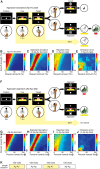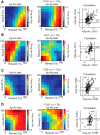Motivation and affective judgments differentially recruit neurons in the primate dorsolateral prefrontal and anterior cingulate cortex
- PMID: 25653353
- PMCID: PMC4315829
- DOI: 10.1523/JNEUROSCI.1731-14.2015
Motivation and affective judgments differentially recruit neurons in the primate dorsolateral prefrontal and anterior cingulate cortex
Abstract
The judgment of whether to accept or to reject an offer is determined by positive and negative affect related to the offer, but affect also induces motivational responses. Rewarding and aversive cues influence the firing rates of many neurons in primate prefrontal and cingulate neocortical regions, but it still is unclear whether neurons in these regions are related to affective judgment or to motivation. To address this issue, we recorded simultaneously the neuronal spike activities of single units in the dorsolateral prefrontal cortex (dlPFC) and the anterior cingulate cortex (ACC) of macaque monkeys as they performed approach-avoidance (Ap-Av) and approach-approach (Ap-Ap) decision-making tasks that can behaviorally dissociate affective judgment and motivation. Notably, neurons having activity correlated with motivational condition could be distinguished from neurons having activity related to affective judgment, especially in the Ap-Av task. Although many neurons in both regions exhibited similar, selective patterns of task-related activity, we found a larger proportion of neurons activated in low motivational conditions in the dlPFC than in the ACC, and the onset of this activity was significantly earlier in the dlPFC than in the ACC. Furthermore, the temporal onsets of affective judgment represented by neuronal activities were significantly slower in the low motivational conditions than in the other conditions. These findings suggest that motivation and affective judgment both recruit dlPFC and ACC neurons but with differential degrees of involvement and timing.
Keywords: anterior cingulate cortex; decision making; macaque; prefrontal cortex; primate.
Copyright © 2015 the authors 0270-6474/15/351939-15$15.00/0.
Conflict of interest statement
The authors declare no competing financial interests.
Figures











References
-
- Belsley DA, Kuh E, Welsch RE. Regression diagnostics: Identifying influential data and sources of collinearity. New York: Wiley; 1980.
Publication types
MeSH terms
Grants and funding
LinkOut - more resources
Full Text Sources
